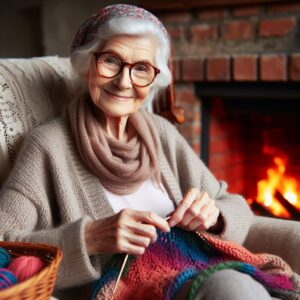Creative Hobbies for Seniors
Creativity doesn’t recognize age—it flourishes when given an outlet at any stage of life. For older adults, artistic activities offer far-reaching benefits, such as cognitive stimulation, stress reduction, and even physical advantages like improved motor skills and hand-eye coordination. Arts and crafts serve as an expressive outlet, providing a voice to experiences and emotions, often leading to a profound sense of fulfillment and self-discovery.
Painting
 Painting is a physical activity as much as it is an emotional and intellectual one. It offers a rewarding method to maintain fine motor skills and hand-eye coordination. As a painter navigates through the composition of his artwork, he is engaging in a physical practice that keeps his joints agile and his mind active.
Painting is a physical activity as much as it is an emotional and intellectual one. It offers a rewarding method to maintain fine motor skills and hand-eye coordination. As a painter navigates through the composition of his artwork, he is engaging in a physical practice that keeps his joints agile and his mind active.
The act of focusing on a canvas allows the mind to relax, leading to reduced stress levels. This calming effect is comparable to the serene state one might achieve through meditation or deep relaxation techniques.
Acrylic paints dry quickly and offer bold colors, making them an excellent choice for beginners. Watercolors can be manipulated to create translucent layers and require a more delicate approach. Oil paints, prized for their richness and depth, may take longer to dry but can produce highly detailed works of art.
Developing painting skills is a gradual process that starts with understanding the basics of color theory and composition. It progresses with practice as the artist becomes more familiar with how different brushes and strokes affect the final image.
The accessibility of painting resources makes it an ideal hobby for older adults. From affordable starter kits that include all necessary materials to free online tutorials that guide technique, seniors can begin to learn and practice at their own pace without a significant investment.
Joining an artistic community can provide invaluable support and motivation. Many community centers and local art schools offer classes tailored to older adults, facilitating social interaction and skill-sharing in a supportive environment.
Knitting
 Knitting is the interlocking of loops of yarn to form a fabric. This can be done by hand with knitting needles or by machine, but it is the act of hand knitting that many find to be a therapeutic and enjoyable hobby. It requires the knitter to focus on the pattern of stitches, which in turn, can help to quiet the mind and divert attention away from daily stressors.
Knitting is the interlocking of loops of yarn to form a fabric. This can be done by hand with knitting needles or by machine, but it is the act of hand knitting that many find to be a therapeutic and enjoyable hobby. It requires the knitter to focus on the pattern of stitches, which in turn, can help to quiet the mind and divert attention away from daily stressors.
Regular engagement in knitting can have positive effects on cognitive function and mental focus. The concentration necessary to follow a knitting pattern has been shown to enhance memory skills and attention span. The coordination required to manipulate the yarn and needles can strengthen fine motor skills, maintaining the agility of the hands and fingers.
A pair of needles and some yarn are all that is required to begin. It may be helpful to choose larger needles and thick yarn to more easily see and handle the stitches. Learning foundational knitting techniques provides the building blocks for more complex patterns.
Many local craft stores, community centers, and libraries offer knitting groups or classes. These gatherings provide social interaction, which is important for emotional well-being. Online communities and video tutorials can offer additional guidance and support for those who may not be able to attend in-person events.
Knitting allows for the creation of a wide variety of items—from scarves and blankets to sweaters and hats. There is a special satisfaction that comes with being able to use or gift an item that one has made with their own hands. Every completed project is a testament to time well spent and skill honed through practice.
Pottery
The basic process of pottery involves shaping moist clay and then subjecting it to high temperatures in a kiln, which hardens the clay into a permanent shape. There are multiple methods for shaping pottery, including hand-building techniques like pinching, coiling, and slab construction, as well as wheel throwing, which uses a rotating wheel to form symmetrical pieces.
The manipulation of clay is hands-on and can enhance tactile sensitivity and fine motor skills. The act of concentrating on molding clay can provide mental focus and alleviate stress, similar to other meditative practices. The sense of accomplishment gained from crafting a piece of pottery is a boon to one’s self-confidence and personal growth.
Taking up pottery as a hobby usually begins with taking classes or workshops. Such settings provide the necessary materials and equipment, such as clay, glazes, and kilns, and an experienced instructor’s guidance. For first endeavors, small projects like cups, bowls, or simple vases are recommended, allowing the novice potter to get a feel for the material.
The artist engages multiple senses: touch as the clay is shaped, sight as the form comes into existence, and even hearing as tools scrape or tap the evolving piece. The intellect is called upon to understand the properties of clay and the physics involved in creating a stable structure.
The open-ended nature of pottery allows individuals to experiment with various shapes, textures, and glazes, which can be especially stimulating and satisfying. Each piece of pottery can become a unique expression of the maker’s creativity, representing a particular moment in their life.
Many who pursue pottery find themselves part of a community of artists and hobbyists who share techniques and ideas. The supportive environment of a pottery studio or class can be particularly enriching, providing an exchange of knowledge.
How to Embrace Artistic Endeavors
To bridge the knowledge gap, one can utilize a variety of resources. Public libraries, community colleges, and senior centers often offer beginner courses in various arts and crafts. For those with internet access, a wealth of instructional content is available online, including video tutorials, workshops, and e-books.
Many craft stores offer discounts, and some shops specialize in affordable, high-quality supplies for beginners. One can consider borrowing materials or sourcing them from second-hand stores to manage costs.
Encouragement from peers is an irreplaceable motivator. Engaging with others who share similar interests can take many forms, such as joining a local craft group, enrolling in classes, or participating in online forums. Interaction with fellow artists can spark inspiration and fuel the desire to continue learning.
Designating an area in one’s home as a creative workspace is instrumental in establishing a routine. This space need should be organized and inviting, to encourage regular engagement with one’s chosen craft.
Carving out a specific time each day or week to focus on a project can help transition from intention to action. This practice helps to create a rhythm that can make the creative process a regular part of life.
To avoid feeling overwhelmed, setting achievable goals is important. Rather than aiming to complete a masterpiece on the first attempt, one should focus on small, attainable objectives. The completion of a simple project or the mastery of a basic technique warrants celebration and encourages further exploration.
The act of sharing one’s work can validate the time and effort invested in the artistic process. Beyond the joy of displaying one’s creations at home, opportunities for sharing include local exhibitions, craft fairs, or digital platforms. Sharing can lead to feedback and connection with an audience, which can be incredibly rewarding.